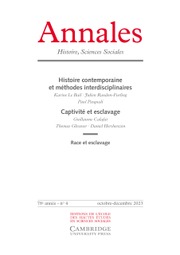(image source: Cambridge Core)
The journal Annales. Histoire, Sciences Sociales published several issues of interest to legal historians
Articles
Enfermement et graffiti Des palimpsestes de prison aux archives murales (note critique) (Guillaume Calafat)
DOI 10.1017/ahss.2024.4
Abstract:DOI 10.1017/ahss.2024.4
In the early 2000s, restoration work on the building that housed Palermo’s Inquisition prisons during the early modern period revealed an impressive series of graffiti and prompted their historical study. In Del Santo Uffizio in Sicilia e delle sue carceri, Giovanna Fiume offers a rich synthesis of the individual and collaborative work she has devoted to these “mural archives” of the Palermo court. Bringing together the procedural and material history of incarceration, she succeeds in identifying the possible authors of the inscriptions and drawings that line the cell walls. In so doing, she sheds light on the trajectories of prisoners and their experiences of imprisonment, often passed over in silence by legal sources. These graffiti thus offer a new layer of documentation that broadens our understanding of the Inquisition’s judicial, penal, and carceral systems. More broadly, Fiume’s work is part of a flourishing strand of recent research dedicated to prisons and graffiti, at the confluence of literary studies, anthropology, and art history, which is interested in both the patrimonial and scholarly dimensions of these graphic marks and their aesthetic and ethnographic aspects. In offering a brief overview of the field, this review article aims to suggest some methodological and historiographical avenues for documenting social and intellectual life inside prisons.
« Dans les rues, on ne voit que des musulmans ! » Esclavage délié et appartenance urbaine en Méditerranée espagnole aux XVIIe et XVIIIe siècles (Thomas Glesener & Daniel Hershenzon)
DOI 10.1017/ahss.2024.3
Abstract:
In 1717, an anonymous petition to the King of Spain expressed concern about the excessive number of Muslims living in Cartagena (Murcia). This complaint prompted the Council of Castile to launch a survey of the Muslim population with the aim of clarifying their status. In addition to galley slaves, the inquiry focused in particular on libertinos, a little-known category of slaves who lived and worked freely in the city but were heavily indebted to their masters because of the sums owed for their ransom. This article reconstructs the condition of these unbound slaves, who lived apart from their masters’ households, and the tensions this provoked between competing systems of norms. On the one hand, the right of slaves to work to finance their own redemption, and that of their masters to live off the rents imposed on them, were deeply rooted in local custom. On the other, rising insecurity along the coast prompted local authorities and the Crown to restrict these overlapping rights by forcing masters to keep their slaves at home. At stake in this conflict between different slavery regimes, the one based on local law and the other on royal jurisdiction, were slaves’ access to the labor market and their right to free residency and the protections afforded by contract law. Finally, by placing the inquiry itself at the heart of the study, the article investigates the meaning of a procedure that was less a demographic enumeration of slaves than a redistribution of rights to the city among its Muslim inhabitants.
Book reviews
- Sinclair Bell et Teresa Ramsby (dir.) Free at Last! The Impact of Freed Slaves on the Roman Empire Londres, Bristol Classical Press, 2012, 212 p. (by Marianne Beraud)
DOI 10.1017/ahss.2024.5 - Craig Perry et al. (dir.) The Cambridge World History of Slavery, vol. 2, AD 500-AD 1420, Cambridge, Cambridge University Press, 2021, 708 p. (by Jean-Claude Hoquet)
DOI 10.1017/ahss.2024.6 - Hannah Barker That Most Precious Merchandise: The Mediterranean Trade in Black Sea Slaves, 1260-1500 Philadelphie, University of Pennsylvania Press, 2019, 328 p. (by Jean-Claude Hoquet)
DOI 10.1017/ahss.2024.7 - Meredith Martin et Gillian Weiss Le Roi-Soleil en mer. Art maritime et galériens dans la France de Louis XIV, Paris, Éd. de l’EHESS, trad. par É. Trogrlic, 2022, 403 p. (by M'hamed Oualdi)
DOI 10.1017/ahss.2024.8 - Fabienne P. Guillén et Roser Salicrú i Lluch Ser y vivir esclavo. Identidad, aculturación y agency (mundos mediterráneos y atlánticos, siglos XIII-XVIII), Madrid, Casa de Velázquez, 2021, 290 p. (by José Antonio Martínez Torres)
DOI 10.1017/ahss.2024.9 - Jean-Frédéric Schaub et Silvia Sebastiani Race et histoire dans les sociétés occidentales, XVe-XVIIIe siècle, Paris, Albin Michel, 2021, 504 p. (by Domitille de Gavriloff)
DOI 10.1017/ahss.2024.10 - Daniel Nemser Infrastructures of Race: Concentration and Biopolitics in Colonial Mexico Austin, University of Texas Press, 2017, 221 p. (by Guillaume Gaudin)
DOI 10.1017/ahss.2024.11 - Jennifer L. Palmer Intimate Bonds: Family and Slavery in the French Atlantic Philadelphie, University of Pennsylvania Press, 2016, 280 p. (by Olivier Caudron)
DOI 10.1017/ahss.2024.13 - Christine Walker Jamaica Ladies: Female Slaveholders and the Creation of Britain’s Atlantic Empire Williamsburg/Chapel Hill, Omohundro Institute of Early American History and Culture/University of North Carolina Press, 2020, 317 p. (by Cécile Vidal)
DOI 10.1017/ahss.2024.15 - Manuel Covo Entrepôt of Revolutions: Saint-Domingue, Commercial Sovereignty, and the French-American Alliance New York, Oxford University Press, 2022, XI + 304 p. (by Éric Roulet)
DOI 10.1017/ahss.2024.16 - Hebe Mattos Les couleurs du silence. Esclavage et liberté dans le Brésil du XIXe siècle trad. par A. Fléchet, Paris/Aubervilliers, Khartala/CIRESC, [1995] 2019, 359 p. (by Aurélia Michel) DOI 10.1017/ahss.2024.21
- Tyler Stovall White Freedom: The Racial History of an Idea Princeton, Princeton University Press, 2021, 436 p. (by Jean-Luc Bonniol)
DOI 10.1017/ahss.2024.22
Read the issue on Cambridge Core.


No comments:
Post a Comment